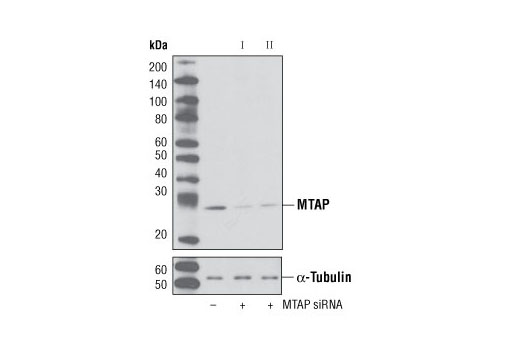#Q13126
4507
Product Information
Product Usage Information
CST recommends transfection with 100 nM MTAP siRNA I 48 to 72 hours prior to cell lysis. For transfection procedure, follow protocol provided by the transfection reagent manufacturer. Please feel free to contact CST with any questions on use.
Each vial contains the equivalent of 100 transfections, which corresponds to a final siRNA concentration of 100 nM per transfection in a 24-well plate with a total volume of 300 μl per well.
Storage
Specificity / Sensitivity
Species Reactivity:
Human
Product Description
Background
MTAP is an enzyme that is essential for the salvage pathway for both adenine and methionine synthesis. MTAP catalyzes the cleavage of 5’-methylthioadenosine into adenine and 5-methylthio-D-ribose-1-phosphate. Adenine is then used to generate AMP whereas 5-methylthio-D-ribose-1-phosphate is converted into methionine (1,2). MTAP is expressed in all normal cells and tissues, although frequently lost in different human tumors, including pancreatic adenocarcinoma, neuroendocrine tumors, non-small cell lung carcinoma, and breast carcinoma. MTAP is usually codeleted with p16 (cdkN2a/ARF) (3-5). MTAP overexpression in breast cancer cells inhibits their ability to form colonies in soft agar, thereby implicating its function as a tumor suppressor (6).
- Backlund, P.S. and Smith, R.A. (1981) J Biol Chem 256, 1533-5.
- Backlund, P.S. et al. (1982) J Biol Chem 257, 4196-202.
- Dreyling, M.H. et al. (1998) Genes Chromosomes Cancer 22, 72-8.
- Zhang, H. et al. (1996) Cancer Genet Cytogenet 86, 22-8.
- Illei, P.B. et al. (2003) Clin Cancer Res 9, 2108-13.
- Christopher, S.A. et al. (2002) Cancer Res 62, 6639-44.
Species Reactivity
Species reactivity is determined by testing in at least one approved application (e.g., western blot).
Cross-Reactivity Key
H: human M: mouse R: rat Hm: hamster Mk: monkey Vir: virus Mi: mink C: chicken Dm: D. melanogaster X: Xenopus Z: zebrafish B: bovine Dg: dog Pg: pig Sc: S. cerevisiae Ce: C. elegans Hr: horse GP: Guinea Pig Rab: rabbit All: all species expected
Trademarks and Patents
Limited Uses
Except as otherwise expressly agreed in a writing signed by a legally authorized representative of CST, the following terms apply to Products provided by CST, its affiliates or its distributors. Any Customer's terms and conditions that are in addition to, or different from, those contained herein, unless separately accepted in writing by a legally authorized representative of CST, are rejected and are of no force or effect.
Products are labeled with For Research Use Only or a similar labeling statement and have not been approved, cleared, or licensed by the FDA or other regulatory foreign or domestic entity, for any purpose. Customer shall not use any Product for any diagnostic or therapeutic purpose, or otherwise in any manner that conflicts with its labeling statement. Products sold or licensed by CST are provided for Customer as the end-user and solely for research and development uses. Any use of Product for diagnostic, prophylactic or therapeutic purposes, or any purchase of Product for resale (alone or as a component) or other commercial purpose, requires a separate license from CST. Customer shall (a) not sell, license, loan, donate or otherwise transfer or make available any Product to any third party, whether alone or in combination with other materials, or use the Products to manufacture any commercial products, (b) not copy, modify, reverse engineer, decompile, disassemble or otherwise attempt to discover the underlying structure or technology of the Products, or use the Products for the purpose of developing any products or services that would compete with CST products or services, (c) not alter or remove from the Products any trademarks, trade names, logos, patent or copyright notices or markings, (d) use the Products solely in accordance with CST Product Terms of Sale and any applicable documentation, and (e) comply with any license, terms of service or similar agreement with respect to any third party products or services used by Customer in connection with the Products.
